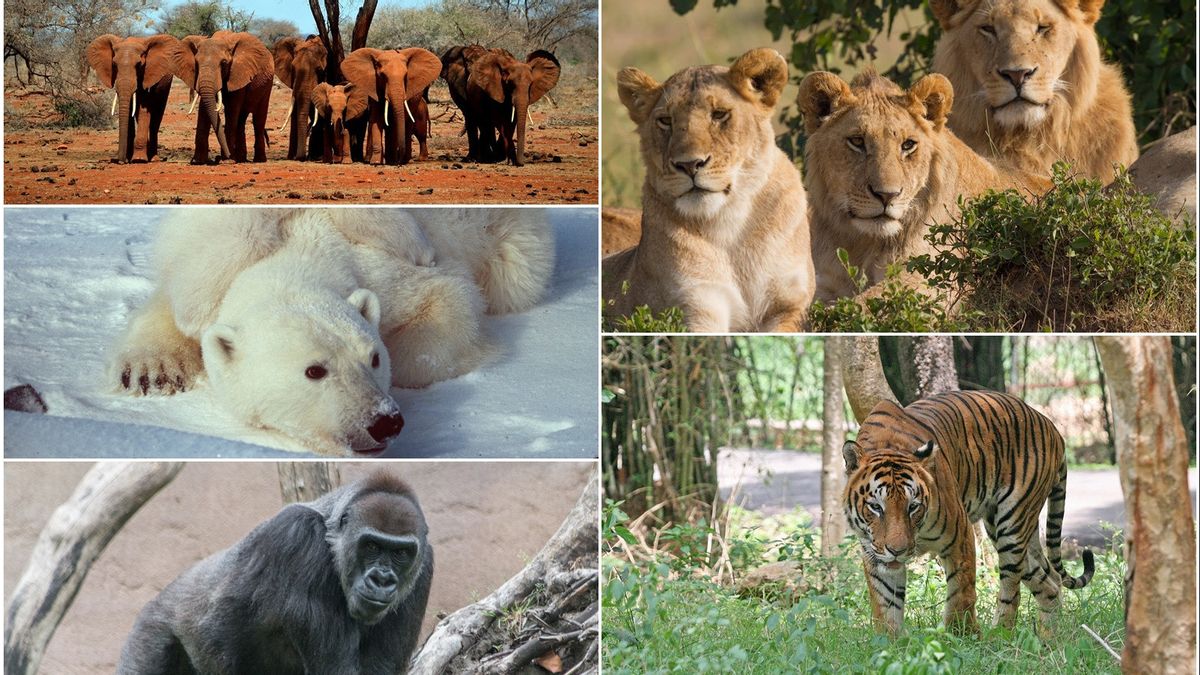JAKARTA - These five animal species were selected as endangered animals. The five are referred to as the 'Big 5' in reference to the term among trophy hunters in Africa.
Yes, the Big 5 is the name among hunters in Africa for the five most valuable and most dangerous animals to hunt, namely elephants, rhinos, leopards, cape buffalo and lions.
Now, more than 250 of the world's nature photographers, conservationists and wildlife charities have come together to reclaim the term and use it to protect, rather than harm, these animals.
"So many face threats to their survival, from issues like hunting, habitat loss to climate change," said renowned conservationist Dr Jane Goodall.
"One million species are threatened with extinction. If we work together, we can stop this from happening. There is always hope. Change is possible if we each play our part."
The five animals selected are key species, meaning they are important for maintaining the ecological balance of their habitat, by playing an important role in the food chain. Without these animals, biodiversity would be reduced and the risk of survival of other species would be increased as well. They are chosen by more than 50,000 wildlife lovers around the world. Launching Euronews, here's the list.
Lion
This symbol of strength and courage has actually been officially labeled vulnerable on the International Union for the Conservation of Nature (IUCN) Red List of Threatened Species. In West Africa they are critically endangered.
Poorly managed human activities, hunting and trophy hunting have seen their numbers drop from around 100,000 in the last century to just 20,000. Conservation groups say we need to act now to save these extraordinary creatures.
“I am very happy that lions are in the new Big 5, because lions need all the attention they can get. They are in serious trouble. The great pride I used to see as a child is starting to disappear,” said Dr Shivani Bhalla, founder of Ewaso Lions.
"I hope that by coming together and giving the lions the attention they deserve, we can overcome this threat and ensure lions roam freely in Africa's spectacular landscapes," he continued.
Elephant
In 1930, as many as 10 million wild elephants roamed Africa. Currently there are only about 455,000 wild elephants in the world due to the elephant ivory trade, poaching and habitat loss.
There are three species of elephant today, African Savannah, African Forest and Asian. In March, the Savanna elephant was listed as critically endangered and the Forest elephant as Critically Endangered by the IUCN. An estimated 55 African elephants per day are still killed by poachers or one every 26 minutes.
"We are currently experiencing the worst string of species deaths since the disappearance of the dinosaurs 65 million years ago," explains wildlife photographer Marsel van Oosten.
"But unlike the mass extinctions of the past, the current crisis is almost entirely caused by us humans," he said.
The area around Chernobyl is a prime example of what can happen if humans stop meddling and make room for animals. After the Chernobyl nuclear disaster, the surrounding area became illegal to live in, and without humans, nature thrived.
Tiger
The number of wild tigers has fallen by more than 95 percent since the early 20th century. Now there are only about 3,159 left and the IUCN classifies them as endangered. Hunting, habitat loss, illegal trade in tiger parts, human activities and climate change are the main causes of this decline.
However, there is hope as tiger conservation efforts are starting to pay off and for the first time in conservation history their numbers continue to grow.
Polar bears
Polar bears face significant threats due to climate change. Polar bears live in icy areas like the Arctic and as their size gets smaller due to global warming, so does their habitat. As a result, global polar bear numbers are projected to decline by 30 percent by 2050.
There are currently only about 26,000 polar bears in the wild and they are already labeled vulnerable by the IUCN, so this will have a devastating effect on the species.
"By taking action on climate change, we will not only ensure the future of polar bears, but also help people. A future that supports polar bears will be a better future for all of us," said the Executive Director of Polar Bears International.
GorillaA broad-scale estimate in 2018 found there are more gorillas in the wild than previously thought. Found about 361,000 western gorillas. However, it is estimated that there are only about 2600 eastern gorillas.
The combination of hunting and disease has left the gorilla critically endangered according to the IUCN. WWF said even if all threats to eastern gorillas were removed, scientists calculated that the population would need about 75 years to recover.
The 'New Big 5' highlights the impact our own actions have on the creatures we share in this world. But they are just the tip of the iceberg. A 2019 UN report found that 1 million animal and plant species are now threatened with extinction.
"We just need to do more," IUCN Species Survival Commission (SSC) Chair Jon Paul Rodríguez said.
The English, Chinese, Japanese, Arabic, and French versions are automatically generated by the AI. So there may still be inaccuracies in translating, please always see Indonesian as our main language. (system supported by DigitalSiber.id)













